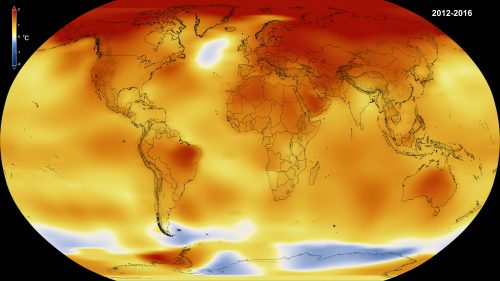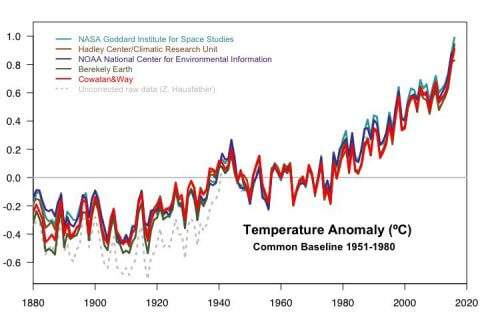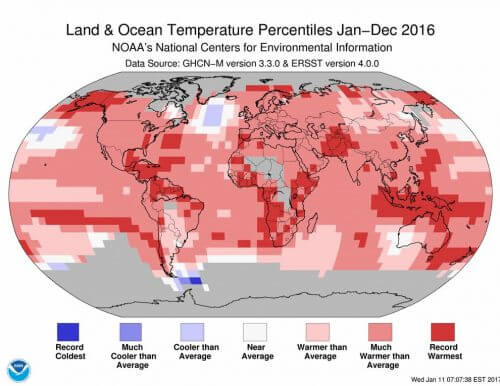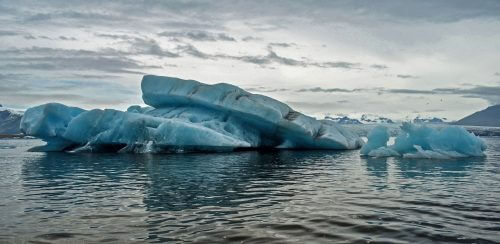NASA and other meteorological organizations declared 2016 as the hottest year since global measurements of the Earth's surface temperature began in 1880. This is the third year in a row that the average global temperature record has been broken. The UK Meteorological Organization was more conservative, declaring 2016 one of the two hottest years on record, along with 2015.

2016 is the warmest year since measurements began in 1880, according to NASA, the National Oceanic and Atmospheric Administration (NOAA) and the World Meteorological Organization yesterday (Wednesday). This is the third year in a row to break global warming records, surpassing 2015, the previous holder In the not-so-respectable degree, at 0.07 degrees Celsius.
According to NASA, in relation to the average of the years 1951 - 1980, in 2016 the average global temperature of the surface was higher by 0.99 degrees Celsius. In relation to the average of the end of the 19th century, the increase recorded in 2016 is 1.1 degrees Celsius - very close to the goal of 1.5 degrees Celsius, which was set as the maximum goal of the increase in global temperature in relation to the pre-industrial period, established in the Paris Agreement in 2015.
Also the US National Oceanic and Atmospheric Agency came to a conclusion that 2016 is the warmest since measurements began. She and NASA jointly announced the data, and said that they reached this conclusion based on the same raw database that comes from thousands of measuring stations around the world, but based on a separate analysis of the data.
"2016 is remarkably the third year in a series of record-breaking years," said Gavin Schmitt, director of NASA's Goddard Center for Space Exploration (GISS), which includes the agency's Surface Temperature Analysis Laboratory. "We don't expect a record-breaking year every time, but the long-term trend of warming is clear," he added.
We just experienced the hottest year on record. How do we know? By analyzing land, sea and Antarctic data: https://t.co/KKXdl1nn2l pic.twitter.com/QETsRDlIny
- NASA (@NASA) January 18, 2017
At the same time, the UK Meteorological Organisation, who announced at the same time For NASA's conclusions, he settled for a more conservative statement, according to which 2016 is one of the two hottest years in history, along with its predecessor, 2015.
According to the British organization, 2016 was 0.77 degrees Celsius warmer than the average of the years 1961-1990, a little more than the increase of 0.76 degrees recorded in 2015. Due to the small difference between the two years, which could be due to a sampling error of 0.1 degrees, the organization settled for a conservative determination More. "2015 was exceptional and clearly stood out from previous years as the warmest since 1850, and now 2016 has become an equally warm year," said Peter Scott, director of the UK Meteorological Organisation.
The World Meteorological Organization, on the other hand, have received the American assertion that 2016 is the warmest since measurements began. According to the various organizations, the differences in determinations stem from the different ways of analyzing the raw data, the period to which 2016 is being compared, as well as a lack of raw data in the polar region.
Whether 2016 is warmer than or equal to the previous year, the more important figure is the overall trend of global warming. According to NASA, most of the recorded warming has happened in the last 35 years, and 16 of the 17 years since 2001 have been the warmest years on record. In addition, five of them broke the average global temperature record - 2005, 2010, 2014, 2015 and now also 2016.

The data also shows that eight of the 12 months of 2016 broke the temperature record relative to their corresponding months, from January to September (except June).
In most of 2015 and the first third of 2016, the "El Niño" phenomenon occurred, which occurs every few years and in which an increase in the temperature of some of the waters of the Pacific Ocean is recorded. NASA and the other organizations emphasized that the phenomenon's contribution to the global average temperature of 2016 was relatively marginal, and even without it, 2016 and 2015 were the hottest.
"A particularly strong El Niño contributed about 0.2 degrees Celsius to the 2016 annual average, which was about 1.1 degrees Celsius above the long-term average for the period from 1850 to 1900. However, the main contributor to warming over the past 150 years is human influence on the climate due to The increase in greenhouse gases in the atmosphere," said Peter Scott, director of the British Meteorological Organization. According to NASA, El Niño's contribution to the annual average was only 0.12 degrees Celsius.
"We understand quite well the impact of El Niño and we have seen it many times. But even if we take that contribution out, it still looks like 2015 and 2016 will be the hottest years we've seen, so the majority comes from global warming and the greenhouse effect." Told the BBC Professor Eli Heywood of the University of Reading. Peter Scott of NASA told the Guardian About 90% of the increase this year was due to the increase in greenhouse gases.

The National Oceanic and Atmospheric Agency of the United States also noted that during the rest of 2016, a parallel phenomenon of "El Niña" occurred, in which cooling of the waters of the Pacific Ocean occurred. Despite this cooling phenomenon, the average temperature of last December was the third warmest since measurements began.
Another noteworthy figure is the extent of the area covered by the sea ice - According to the US Oceanic and Atmospheric Agency The area of sea ice in the Arctic region in 2016 was estimated at 10.1 million square kilometers, the lowest since measurements of this figure began in 1979. The sea ice in the Antarctic region stood at 11.1 million square kilometers, the second lowest since measurements began in 1979.
“The spate of record-breaking warm years we've had in the 21st century can only be explained as being caused by man-made climate change. The effect of human activity on our climate is no longer moderate. It is as clear as the sun, as are the effects – in the form of floods, droughts, superstorms and record-breaking fires – that it has on us and our planet,” said Professor Michael Mann, director of the Earth Research Center at Pennsylvania State University, according to CNN report.


12 תגובות
You mean a new conspiracy theory is revealed.
http://mida.org.il/2017/02/08/%D7%9E%D7%93%D7%A2%D7%9F-%D7%90%D7%A7%D7%9C%D7%99%D7%9D-%D7%91%D7%9B%D7%99%D7%A8-%D7%97%D7%95%D7%A6%D7%94-%D7%90%D7%AA-%D7%94%D7%A7%D7%95%D7%95%D7%99%D7%9D-%D7%95%D7%97%D7%95%D7%A9%D7%A3-%D7%94%D7%95/
Another impressive video of the Ice Maidens over the years
http://edition.cnn.com/2016/11/02/us/old-arctic-sea-ice-vanishing/index.html?sr=fbCNN011517old-arctic-sea-ice-vanishing1100AMVODtopLink&linkId=33379514
For miracles - Bush Jr. beamed with pride at the coronation. Now he is considered a genius.
Sorry, that anonymous was me.
Trump has already canceled algebra. Count 750,000 people at his coronation according to the Washington Subway figures, while the railroad published a figure of 190,000. And then he sent his spokesman to shout at the newspapers that they had published incorrect data.
safkan
Global warming, like evolution, is an observational fact. The species are changing, the weather is warming and the ice is melting.
What's more - we can discuss the reasons for the warming. To help you understand, I would appreciate it if you could explain to me which of the following sentences Tetha agrees with and which she does not.
1. Man emits about 10 billion tons of GHG into the atmosphere every year.
2. PADH is a greenhouse gas.
3. The weather is warming up, even though we should have been in a cooling cycle.
By the way - Trump and his advisors do not accept evolution and are anti-vaccinationists. This does not mean that he is a genius.
Skeptic, next step Trump will cancel gravity
US President Trump has canceled (man-made) global warming. He in particular canceled the huge budgets and regulations that were amended to supposedly prevent catastrophic global warming.
Following moves, they would stop confusing our brains with dire predictions aimed at getting budgets for brain confusion and transferring money to the pockets of the rich (the rich benefit from all these regulations and this is the real reason for the brain confusion).
According to the outline of the warming in the last hundred and twenty years (including a large slowdown in warming, it is not expected that the warming by the end of the century 2100 will not be higher than one degree Celsius.
Also, according to this outline, the expected sea level rise by the year 2100 is only 25 cm (this is the rate of sea level rise in the last hundred years and nothing has changed in the rate of sea level rise).
In another ten years they won't mention global warming at all because those who continue to confuse the brain will have to look for a new job (due to the lack of budgeting for brain confusion).
Maybe the end of the era of primates called man is closer than we thought, the ball will continue to spin without us with other species and varieties, some new and some not